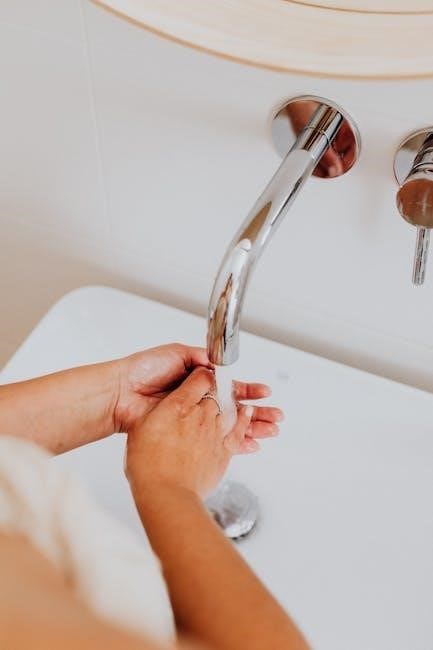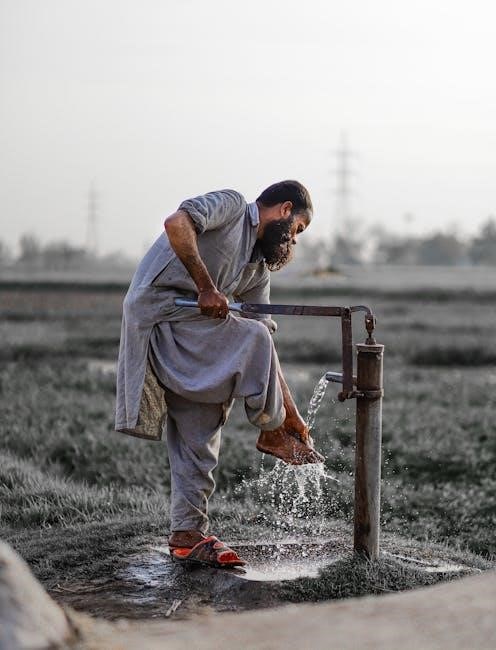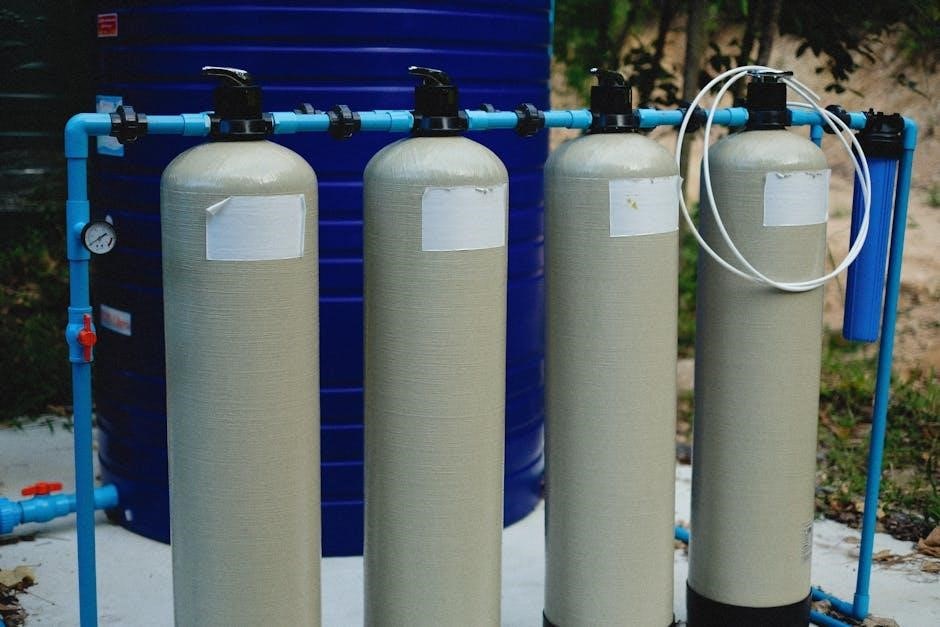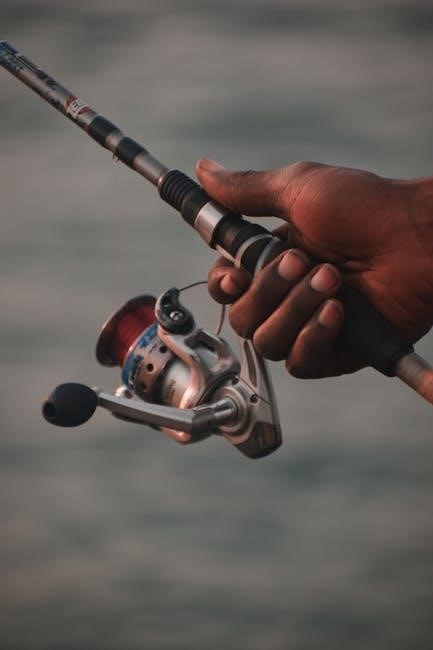what is requirement of a manual water pump
Manual water pumps are hand-operated devices crucial for removing water from boats, ensuring stability and preventing capsizing. They are reliable in emergencies, especially when electric systems fail.
1.1 Overview of Manual Water Pumps
A manual water pump is a device designed to lift or transfer water from a source, such as a well or tank, using human effort. These pumps operate without electricity, relying instead on mechanical action to create suction and discharge water. They are often simple in design, consisting of a cylinder, piston, and valves that work together to draw water upward. Manual pumps are versatile and can be used in various settings, including rural areas, emergency situations, and marine environments. Their primary requirement is consistent human operation to maintain the flow of water. They are valued for their reliability, simplicity, and ability to function in off-grid conditions, making them a practical solution for accessing water in remote or resource-limited locations.
1.2 Historical Background and Evolution
The manual water pump has a long history dating back to ancient civilizations, where people first needed reliable ways to access water. Early versions included simple bucket-and-rope systems, while more advanced designs emerged in ancient Rome, such as force pumps used for firefighting and irrigation. By the Middle Ages, manually operated piston pumps became common in Europe, particularly for draining water from mines. The Industrial Revolution brought significant advancements, with the development of cast-iron and steel pumps that were more durable and efficient. Over time, manual pumps evolved to serve diverse purposes, from maritime use to rural water supply. In the 20th century, designs were refined for specific applications, such as bilge pumps on ships and hand pumps for wells in developing regions. Today, manual water pumps remain essential tools, offering simplicity and reliability in various contexts.
Types of Manual Water Pumps
Manual water pumps are categorized into single-action and double-action types, with single-action being simpler and double-action offering higher efficiency, suitable for different water extraction needs.
2.1 Single-Action Manual Pumps
Single-action manual pumps operate with a simple mechanism where water is drawn on the downward stroke of the piston and discharged on the upward stroke. This design is straightforward, making it ideal for shallow water sources and low-flow applications. They are often used in emergency situations due to their reliability and ease of operation. These pumps typically require minimal installation and maintenance, making them a practical choice for small-scale water needs. Their simplicity ensures they can function effectively in remote or off-grid settings without relying on external power sources. This makes single-action pumps a popular option for basic water extraction requirements in both marine and terrestrial environments.
2.2 Double-Action Manual Pumps
Double-action manual pumps are designed to pump water during both the upward and downward strokes of the piston, unlike single-action pumps. This dual operation increases efficiency and flow rate, making them suitable for applications requiring higher water output. These pumps are often used in scenarios where a steady and substantial water supply is needed, such as in larger vessels or for irrigation in agricultural settings. Their robust construction ensures durability, even in demanding environments. Double-action pumps are preferred when faster water extraction is critical, offering improved performance compared to single-action models. This makes them a reliable choice for users needing consistent and efficient water pumping solutions.

Requirements for Manual Water Pumps
Manual water pumps must meet specific performance, durability, and safety standards to ensure reliable operation in various environments and applications.
3.1 Size and Capacity Requirements
The size and capacity of a manual water pump are critical to ensure it meets the intended application’s needs. Pumps come in various sizes, ranging from small, portable models to larger, stationary units. The capacity, measured in liters per minute (L/min) or gallons per minute (GPM), must align with the water demand. For example, a pump used for bilging a small boat may require a flow rate of 10-20 GPM, while a pump for irrigation might need higher capacity. The size of the pump’s cylinder and stroke length directly influence its output. Proper sizing ensures efficiency and avoids underperformance. It’s essential to match the pump’s capacity with the water volume required for the specific task to ensure optimal functionality and reliability.
3.2 Flow Rate Specifications
Flow rate specifications are essential for determining a manual water pump’s performance. The flow rate, typically measured in liters per minute (L/min) or gallons per minute (GPM), indicates how much water the pump can move over time. For example, a pump with a flow rate of 10 GPM can discharge 10 gallons of water every minute. This specification is crucial for applications like bilging, irrigation, or emergency water supply, where consistent and reliable water flow is necessary. The flow rate depends on factors such as the pump’s piston size, stroke length, and handle effort. Higher flow rates are achieved with larger pistons and longer strokes, but this may increase the physical effort required to operate the pump. Selecting a pump with the appropriate flow rate ensures it meets the demands of the intended use without compromising efficiency or usability.
3.3 Construction Materials and Durability
The construction materials of a manual water pump play a critical role in its durability and performance. Common materials include bronze, stainless steel, and durable plastics, each offering unique benefits. Bronze is known for its resistance to corrosion, making it ideal for marine environments, while stainless steel provides exceptional strength and longevity. Plastic components are often used for lighter applications and cost-effectiveness but may not withstand heavy-duty use. The pump’s durability is further enhanced by reinforced handles and robust seals, ensuring leak-free operation. Proper material selection ensures the pump can withstand harsh conditions, such as saltwater or extreme temperatures. Durable construction materials are essential for maintaining reliability and extending the pump’s lifespan, especially in demanding environments like maritime or rural settings. High-quality materials minimize wear and tear, reducing the need for frequent repairs and ensuring consistent performance over time.
3.4 Installation Guidelines
Proper installation of a manual water pump is crucial for its efficiency and longevity. The pump should be mounted on a stable, level surface to ensure even operation. In marine applications, it is often installed in the bilge area, while in rural settings, it may be placed near a water source like a well or pond. The suction hose should be submerged in water, and the discharge hose should be directed away from the pump to prevent backflow. Secure the pump with brackets or bolts to withstand vibrations and movement. Ensure all connections are tight to avoid leaks. Regularly inspect the installation site for debris or obstructions. Following the manufacturer’s instructions is essential for a correct and safe setup. Proper installation ensures reliable performance and minimizes the risk of mechanical failure. Always test the pump after installation to confirm its functionality.

Importance of Manual Water Pumps
Manual water pumps provide reliable water supply in emergencies, remote areas, and marine environments, ensuring safety and sustainability without electricity, making them essential for various applications globally.
4.1 Role in Marine Safety
Manual water pumps play a critical role in marine safety by providing a reliable means to remove water from vessels in emergency situations. Their ability to function without electricity makes them indispensable for bail-out operations, ensuring crew and passenger safety. The pump’s size and capacity must align with the vessel’s needs to effectively manage water ingress. Durable construction materials, such as stainless steel or bronze, are essential to withstand harsh marine environments. Proper installation is crucial to ensure quick access and efficient operation during emergencies. These pumps serve as a backup to electrical systems, which may fail in critical situations. By meeting specific maritime regulations, they help prevent potential disasters, making them a vital component of marine safety equipment.
4.2 Applications in Rural and Off-Grid Areas
Manual water pumps are essential in rural and off-grid areas where access to electricity is limited or unreliable. They provide a sustainable solution for water extraction, supporting irrigation, livestock watering, and household needs. Their simplicity and reliability make them ideal for remote communities, ensuring consistent water supply without dependence on power. Durable construction materials, such as galvanized steel or cast iron, are crucial for withstanding outdoor conditions. Easy installation and low maintenance requirements further enhance their practicality. These pumps are cost-effective, offering long-term savings compared to electric alternatives. Additionally, they serve as a backup during power outages, ensuring uninterrupted access to water. Their versatility and efficiency make them a vital tool for self-sufficient living in off-grid environments, addressing critical water needs effectively.

Design and Functionality
Manual water pumps are designed for efficiency, with durable materials like stainless steel or brass ensuring longevity. Their compact, portable design makes them ideal for various applications, requiring minimal maintenance while delivering consistent water flow.
5.1 Operating Mechanism and Components
A manual water pump operates through a simple yet effective mechanism. It consists of a handle, piston, cylinder, and valves. The handle is connected to the piston, which moves up and down inside the cylinder. As the handle is pressed down, the piston creates suction, drawing water from the source through the suction pipe. On the upward stroke, the piston pushes water out through the discharge pipe. Check valves ensure water flows in one direction, preventing backflow. The pump also includes a foot valve at the suction end to aid in priming. These components work together to provide a reliable and efficient way to transfer water manually.
5.2 Key Features for Efficiency
A manual water pump’s efficiency relies on several key features. First, durable construction materials like stainless steel or high-quality plastics ensure longevity and resistance to corrosion. A smooth, ergonomic handle design reduces fatigue during operation, while a tight seal between the piston and cylinder minimizes water leakage. The pump’s suction and discharge valves are critical for maintaining consistent flow rates. Lightweight components enhance portability, making the pump easy to transport and install. Additionally, some models include adjustable stroke lengths to optimize water output based on user strength. Efficient manual pumps also feature quick-priming mechanisms to reduce the effort needed to start water flow; These design elements collectively ensure reliable performance, making manual water pumps a practical solution for various applications.
5.3 Suction and Discharge Process

The suction and discharge process in a manual water pump involves the movement of water from a source to a desired location through mechanical operation. When the handle is turned, it activates the piston inside the pump. As the piston descends, it creates a vacuum, opening the suction valve and drawing water into the cylinder. Upon ascending, the piston pushes the water through the discharge valve, directing it outward. This repetitive motion ensures continuous water flow. Check valves prevent backflow, maintaining efficiency. The pump’s design, including piston size and valve arrangement, influences flow rate and effort required. Priming may be necessary to initiate water movement. Durable materials like stainless steel or plastics ensure longevity. Understanding this process highlights the pump’s reliability in applications like marine safety and rural water supply, where consistent and efficient water transfer is crucial.

Safety Regulations
Manual water pumps must comply with maritime safety standards, ensuring proper installation and operation to prevent accidents and environmental hazards.
6.1 Overview of Maritime Regulations
Maritime regulations for manual water pumps are established to ensure safety, prevent environmental pollution, and comply with international standards. These regulations, often mandated by organizations like the International Maritime Organization (IMO) and the U.S. Coast Guard, outline specific requirements for pump design, installation, and operation. Compliance ensures the pump’s reliability in emergency situations, such as bilge water removal, and prevents contamination of waterways. Key aspects include certification by recognized bodies, regular inspections, and adherence to material standards to withstand harsh marine conditions. Vessels of various sizes must meet these criteria to operate legally and safely. Failure to comply can result in penalties and operational risks. Thus, understanding and adhering to these regulations is crucial for marine safety and environmental protection.
6.2 Vessel Size and Pump Requirements
Vessel size significantly influences the type and capacity of manual water pumps required. Larger vessels generally need more robust pumps to handle greater water volumes, while smaller boats may require smaller, lighter options. Maritime regulations specify the minimum pump capacity based on the vessel’s size, ensuring it can efficiently manage water in emergency situations. For example, larger ships may require pumps with higher flow rates to address potential flooding or bilge water removal. The materials and construction of the pump must also align with the vessel’s size to ensure durability and performance. Proper installation, as per guidelines, is crucial to guarantee the pump’s effectiveness. These requirements aim to balance safety, efficiency, and practicality for various vessel sizes, ensuring compliance with maritime standards while addressing specific operational needs.
6.3 Exemptions for Specific Vessels
Certain vessels may be exempt from standard manual water pump requirements based on their size, usage, or operational conditions. For instance, smaller vessels, such as dinghies or flat-bottom boats, may not require a dedicated manual pump if they meet specific safety criteria. Similarly, boats operating in shallow waters or those used exclusively in protected harbors might be exempt due to lower flooding risks. Exemptions are typically outlined in maritime regulations and aim to reduce unnecessary burdens on vessel owners while maintaining safety standards. However, even exempt vessels may still need alternative safety measures, such as portable pumps or bailers, to ensure basic water removal capabilities. These exemptions balance practicality and safety, ensuring that smaller or specialized vessels are not overly encumbered by stringent pump requirements.

Maintenance and Troubleshooting
Regular maintenance ensures optimal performance and extends the lifespan of manual water pumps. Inspect moving parts, check for wear, and replace worn seals or O-rings promptly.
7.1 Routine Maintenance Tips
Regular lubrication of moving parts ensures smooth operation and prevents corrosion. Inspect the pump cylinder, piston, and valves for wear and tear. Replace worn O-rings or gaskets immediately to avoid leaks. Flush the pump with clean water after use to remove impurities. Check the suction hose for kinks or blockages and ensure it is properly secured. Inspect the pump chamber for sediment buildup and clean it periodically; Align the handle and connecting rod correctly to maintain efficient pumping action. Follow the manufacturer’s guidelines for grease application and part replacement. Store the pump in a dry, protected area when not in use to prevent damage. Regular maintenance ensures reliability and extends the pump’s lifespan, making it ready for emergencies or consistent use.
7.2 Common Issues and Solutions
Common issues with manual water pumps include air leaks, low water output, and handle stiffness. Air leaks often occur due to loose connections or worn gaskets, which can be fixed by tightening parts or replacing seals. Low water output may result from a blocked suction hose or foot valve, requiring cleaning or replacement. Stiff handles can be resolved by lubricating pivot points. If the pump fails to suck water, check for obstructions in the suction pipe or ensure the pump is submerged adequately. Leaks around the piston or O-rings should be addressed by replacing worn components. For slow flow rates, inspect for clogs in the discharge pipe or worn valves. Regularly checking and addressing these issues ensures optimal performance and extends the pump’s service life. Always refer to the manufacturer’s manual for specific troubleshooting guidance.

Advantages of Manual Water Pumps
Manual water pumps are reliable, cost-effective, and environmentally friendly, offering a sustainable solution for water needs without electricity, ideal for emergencies and remote areas.
8.1 Reliability in Emergency Situations
Manual water pumps are highly reliable in emergency situations, such as power outages or natural disasters, where electricity-dependent systems fail. Their simplicity and durability ensure consistent performance, making them indispensable for marine vessels, rural communities, and off-grid locations.
These pumps require no external power source, operating solely on manual effort, which enhances their dependability. In marine settings, they are often mandated for emergency bilge extraction, ensuring crew safety. Similarly, in rural areas, they provide a failsafe for accessing clean water during crises. Their low maintenance and ease of operation further contribute to their reliability, making them a critical tool in emergency preparedness and response systems worldwide.

8.2 Cost-Effectiveness and Low Maintenance
Manual water pumps are highly cost-effective, offering a budget-friendly solution for water extraction and transfer needs. Unlike electric pumps, they require no electricity, reducing operational costs and eliminating the need for costly power sources. This makes them ideal for rural, off-grid, or marine applications where resources are limited.

Environmental Impact
Manual water pumps offer an eco-friendly alternative by eliminating electricity use, reducing carbon emissions, and promoting water conservation through efficient extraction and minimal waste generation always.
9.1 Role in Preventing Water Pollution
Manual water pumps play a significant role in preventing water pollution by offering an eco-friendly alternative to electric pumps. They eliminate the risk of oil or chemical spills associated with mechanical failures in electric systems. By promoting sustainable water extraction, these pumps help maintain water quality and prevent contamination. Their simple design reduces the likelihood of hazardous material leakage, making them ideal for marine environments where preventing water pollution is critical. Additionally, manual pumps encourage responsible water usage, reducing the chances of over-extraction that can harm aquatic ecosystems. Overall, they contribute to preserving water purity and promoting environmental health, making them a valuable tool in protecting our water resources from pollution.
Manual water pumps are indispensable, reliable, and cost-effective solutions for water supply needs, excelling in emergencies and offering sustainable access to clean water in diverse environments.
10.1 Summary of Key Points
Manual water pumps are essential tools requiring specific criteria to ensure functionality and efficiency. Key considerations include size, capacity, and flow rate, tailored to the intended application; Construction materials must be durable, resistant to corrosion, and suitable for the operating environment. Proper installation is critical, adhering to guidelines for optimal performance and safety. Compliance with maritime regulations is vital, particularly for vessel safety, ensuring pumps meet size and capacity standards. Regular maintenance is necessary to prevent issues and extend lifespan. Understanding these requirements helps in selecting the right pump for specific needs, ensuring reliability and cost-effectiveness in various scenarios, from marine emergencies to rural water supply. Balancing these factors makes manual water pumps a versatile and indispensable solution.
